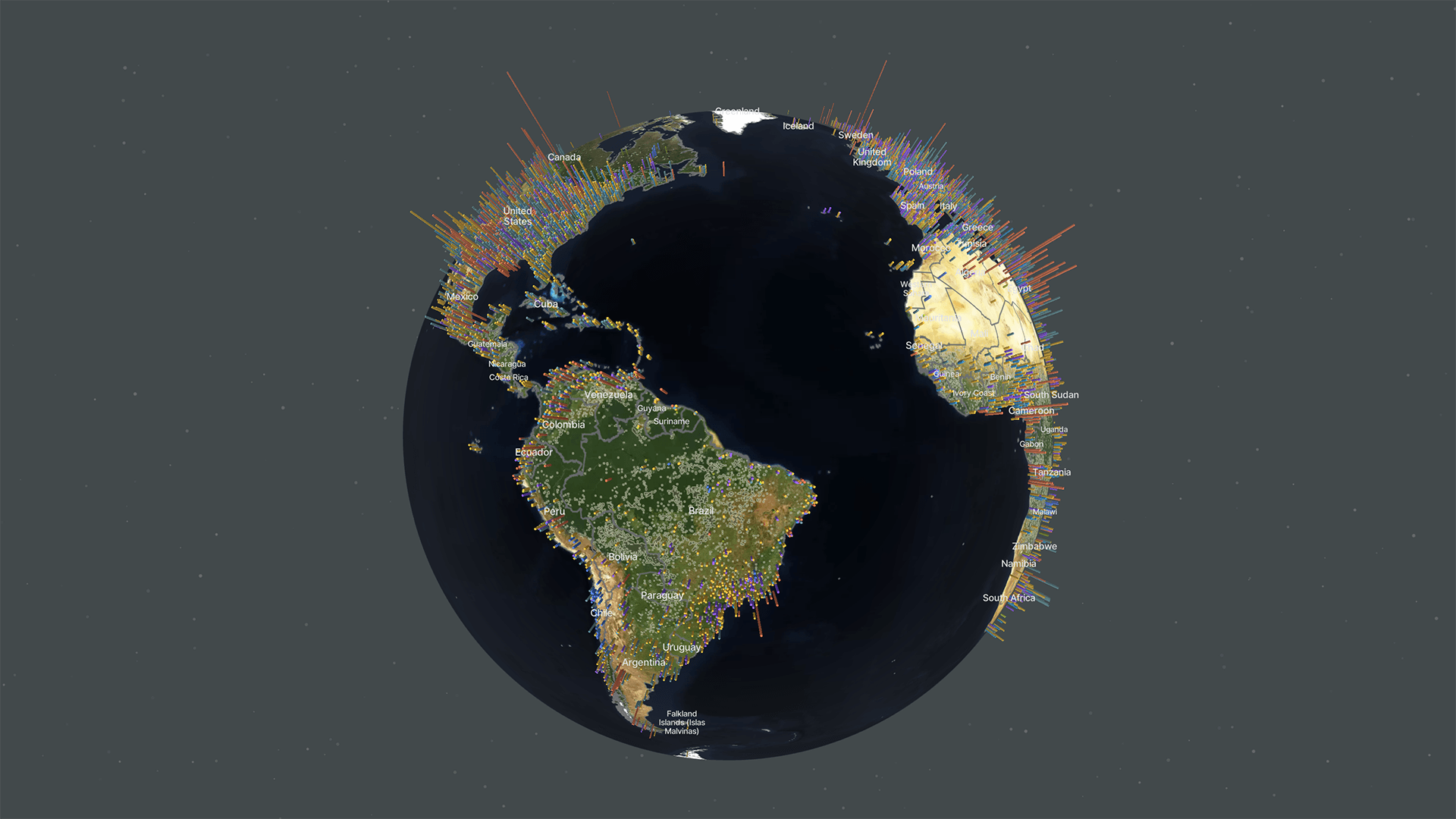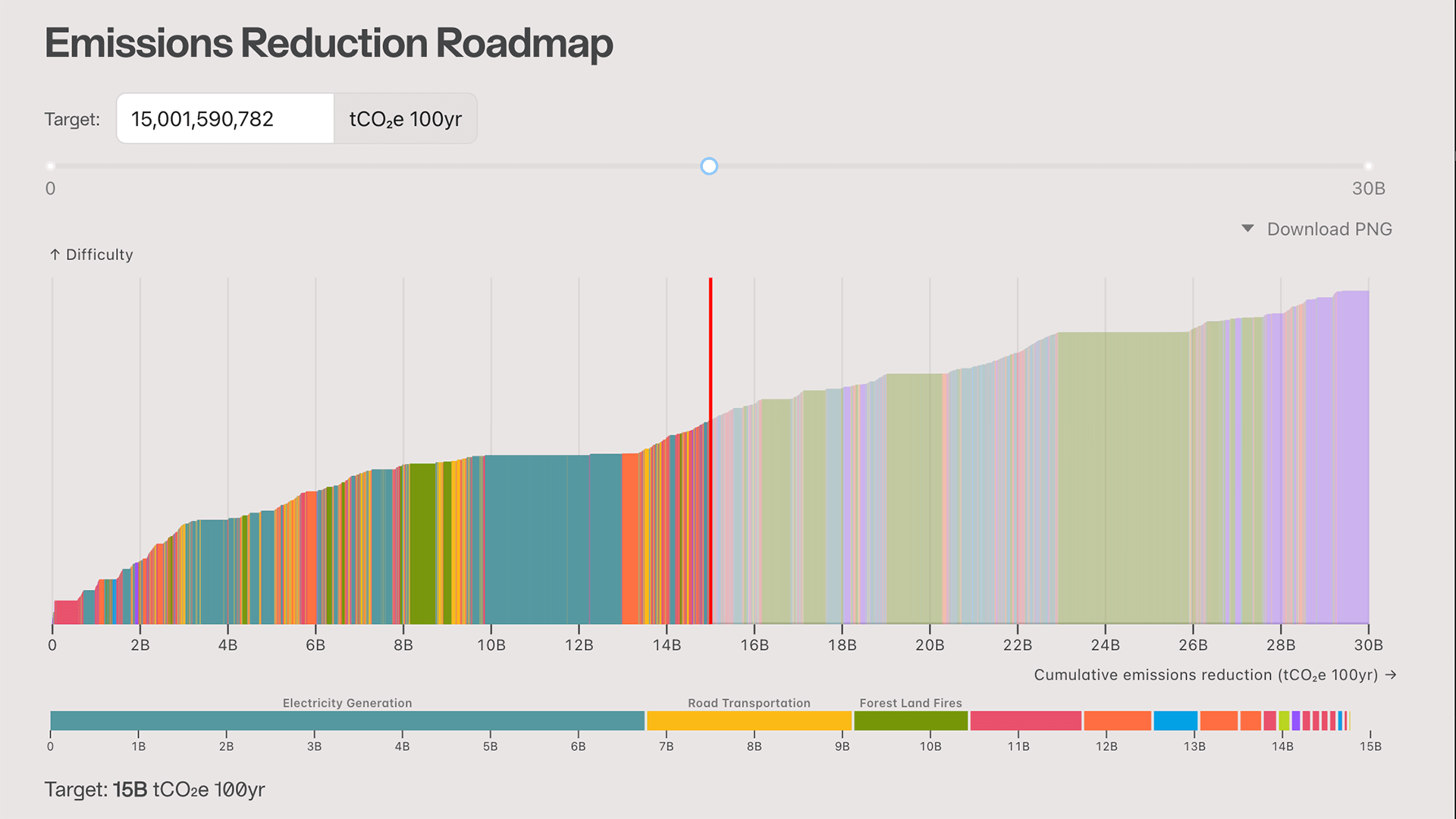Climate TRACE Releases July 2025 Emissions Data
September 25, 2025 -- Today, Climate TRACE reported that global greenhouse gas emissions for the month of July 2025 totaled 5.21 billion tonnes CO₂e. This represents an increase of 0.43% vs. July 2024. Total global year-to-date emissions are 36.26 billion tonnes CO₂e. This is 0.39% higher than 2024's year-to-date total. Global methane emissions in July 2025 were 34.57 million tonnes CH₄, an increase of 0.50% vs. July 2024.
Data tables summarizing emissions totals for July 2025 by sector, country, and top 100 urban areas are available for download here.
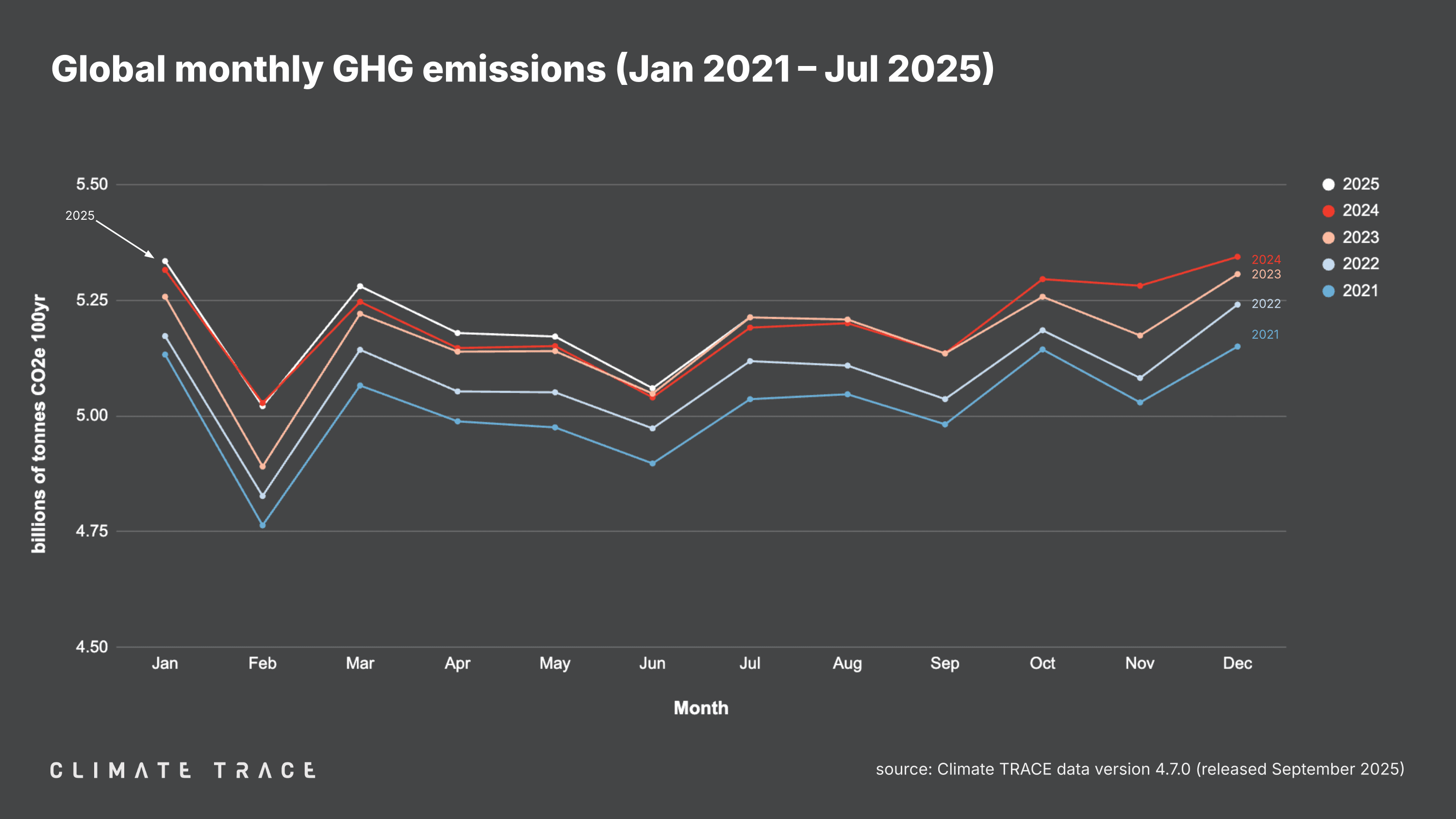


Greenhouse Gas Emissions by Country: July 2025
Climate TRACE's preliminary estimate of July 2025 emissions in China, the world's top emitting country, is 1.55 billion tonnes CO₂e --- an increase of 1.45 million tonnes of CO₂e or 0.09% vs. July 2024.
Of the other top five emitting countries:
-
United States emissions increased by 7.95 million tonnes CO₂e, or 1.34% year over year;
-
India emissions increased by 1.63 million tonnes CO₂e, or 0.46% year over year;
-
Russia emissions declined by 0.38 million tonnes CO₂e, or 0.15% year over year;
-
Brazil emissions increased by 1.33 million tonnes CO₂e, or 1.10% year over year.
In the EU, which as a bloc would be the fourth largest source of emissions in July 2025, emissions increased by 0.86 million tonnes CO₂e compared to July 2024, or 0.28%.
Greenhouse Gas Emissions by Sector: July 2025
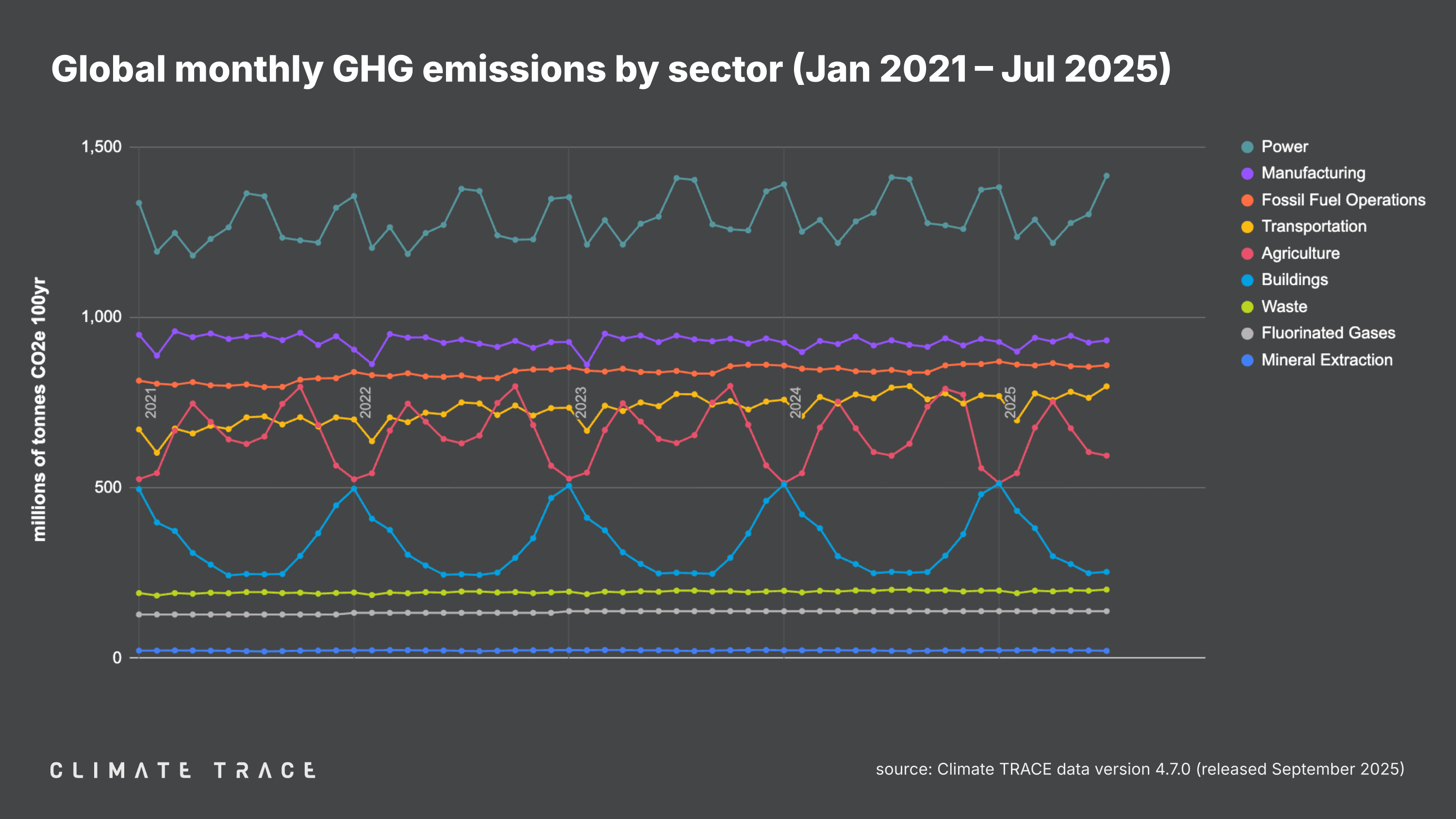
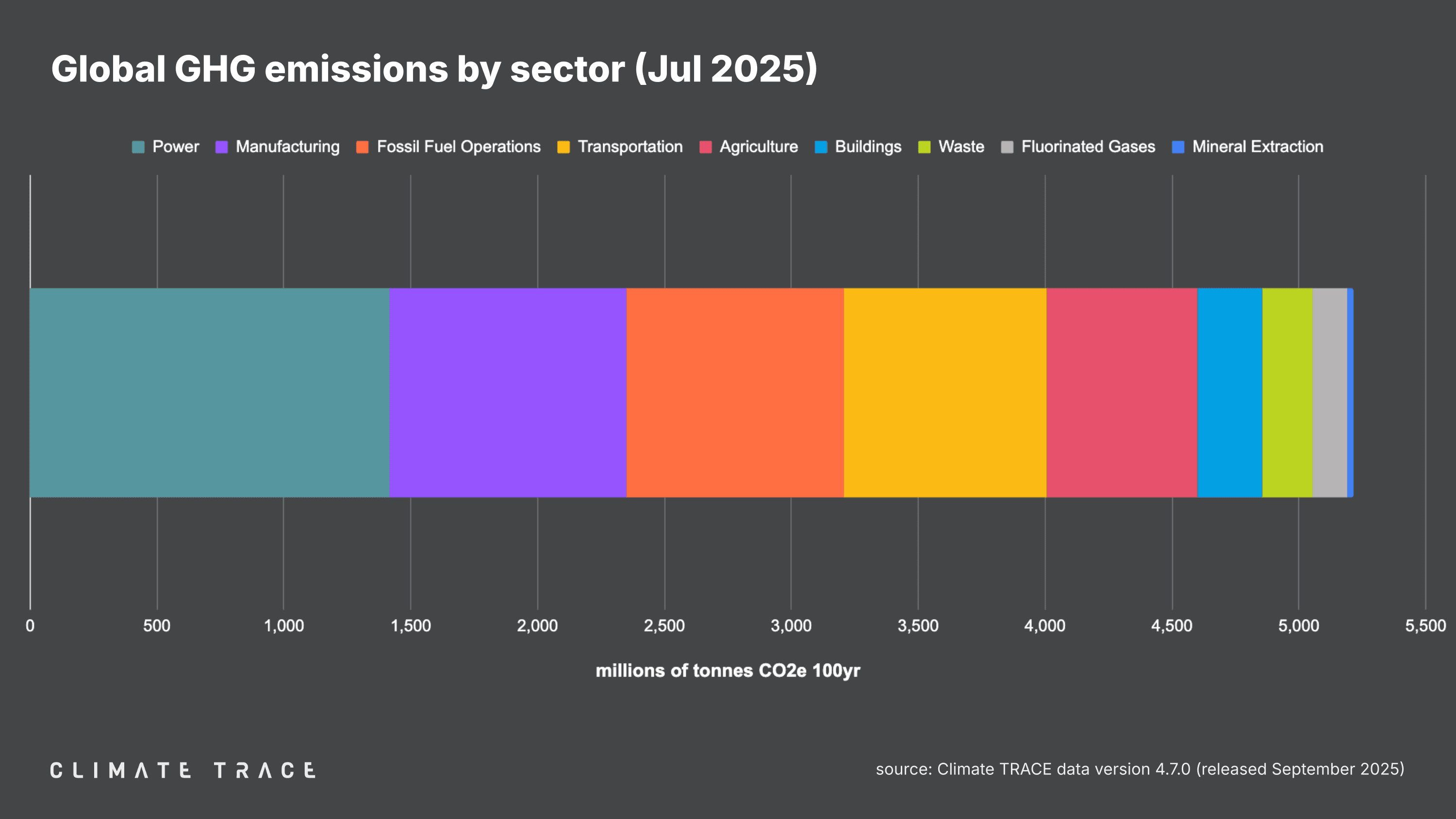
Greenhouse gas emissions increased in July 2025 vs. July 2024 in fossil fuel operations, power, transportation, and waste, and decreased in manufacturing. Fossil fuel operations saw the greatest change in emissions year over year, with emissions increasing by 1.62% as compared to July 2024.
-
Agriculture emissions were 594.33 million tonnes CO₂e, unchanged vs. July 2024;
-
Buildings emissions were 253.17 million tonnes CO₂e, unchanged vs. July 2024;
-
Fluorinated gases emissions were 137.71 million tonnes CO₂e, unchanged vs. July 2024;
-
Fossil fuel operations emissions were 859.45 million tonnes CO₂e, a 1.62% increase vs. July 2024;
-
Manufacturing emissions were 932.51 million tonnes CO₂e, a 0.03% decrease vs. July 2024;
-
Mineral extraction emissions were 21.36 million tonnes CO₂e, unchanged vs. July 2024;
-
Power emissions were 1,415.87 million tonnes CO₂e, a 0.34% increase vs. July 2024;
-
Transportation emissions were 797.65 million tonnes CO₂e, a 0.48% increase vs. July 2024;
-
Waste emissions were 201.12 million tonnes CO₂e, a 0.27% increase vs. July 2024.
Greenhouse Gas Emissions by City: July 2025
The urban areas with the highest total greenhouse gas emissions in July 2025 were Shanghai, China; Tokyo, Japan; New York, United States; Houston, United States; and Los Angeles, United States.
The urban areas with the greatest increase in absolute emissions in July 2025 as compared to July 2024 were Dortmund, Germany; Pittsburgh, United States; Xinyu, China; Obra, India; and Bhusawal, India. Those with the largest absolute emissions decline between this July and last July were UNNAMED, India; Holland, United States; Guangzhou, China; Houston, United States; and Anchorage, United States.
The urban areas with the greatest increase in emissions as a percentage of their total emissions were Bandar Ganaveh, Iran; Maumere, Indonesia; Kombissiri, Burkina Faso; Mocímboa da Praia, Mozambique; and UNNAMED, Sudan. Those with the greatest decrease by percentage were Manokwari, Indonesia; UNNAMED, India; Tuxtepec, México; Koko Town, Nigeria; and Azov, Russia.
RELEASE NOTES
Revisions to existing Climate TRACE data are common and expected. They allow us to take the most up-to-date and accurate information into account. As new information becomes available, Climate TRACE will update its emissions totals (potentially including historical estimates) to reflect new data inputs, methodologies, and revisions.
With the addition of July 2025 data, the Climate TRACE database is now updated to version V4.7.0. This release includes updates across more than 18 sectors: revised PM2.5 estimates for mining, refining, and transport; monthly emissions data for Southeast Asian rice cultivation; biomass-specific emissions in buildings; and expanded asset coverage with 572 coal mines, 39 aluminum facilities, 93 pulp-and-paper facilities, and 1,248 ports in shipping. Shipping models were upgraded with improved vessel characteristics and port attribution.
A detailed description of data updates is available in our changelog here.
To learn more about what is included in our monthly data releases and for frequently asked questions, click here. All methodologies for Climate TRACE data estimates are available to view and download here. For any further technical questions about data updates, please contact: coalition@ClimateTRACE.org.
To sign up for monthly updates from Climate TRACE, click here.
Emissions data for August 2025 are scheduled for release on October 30, 2025.
About Climate TRACE
The Climate TRACE coalition was formed by a group of AI specialists, data scientists, researchers, and nongovernmental organizations. Current members include Carbon Yield; Carnegie Mellon University's CREATE Lab; CTrees; Duke University's Nicholas Institute for Energy, Environment & Sustainability; Earth Genome; Former Vice President Al Gore; Global Energy Monitor; Global Fishing Watch/emLab; Hypervine.io; Johns Hopkins University Applied Physics Lab; OceanMind; RMI; TransitionZero; and WattTime. Climate TRACE is also supported by more than 100 other contributing organizations and researchers, including key data and analysis contributors: Arboretica, Michigan State University, Ode Partners, Open Supply Hub, Saint Louis University's Remote Sensing Lab, and University of Malaysia Terengganu. For more information about the coalition and a list of contributors, click here.
Media Contacts
Fae Jencks and Nikki Arnone for Climate TRACE

